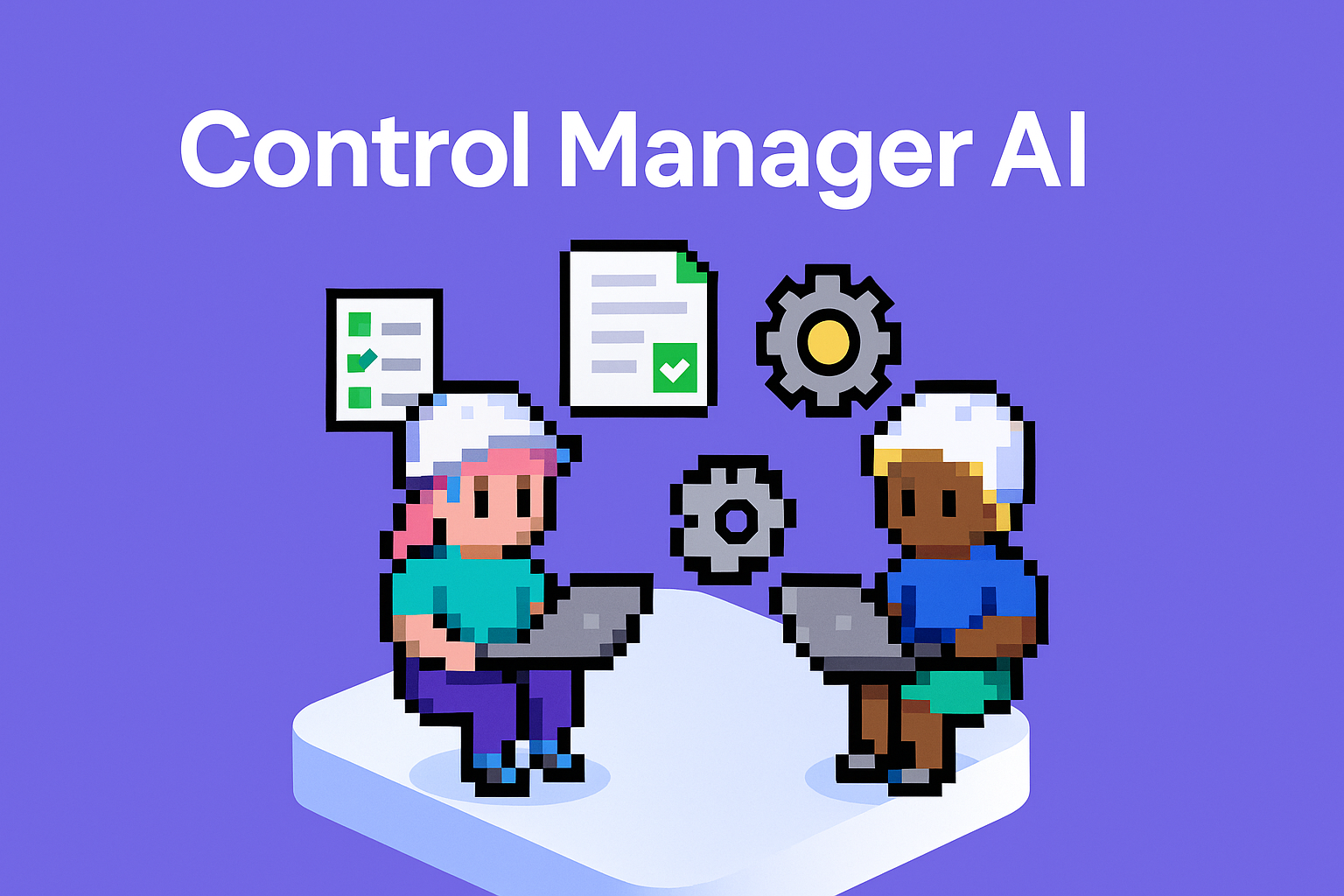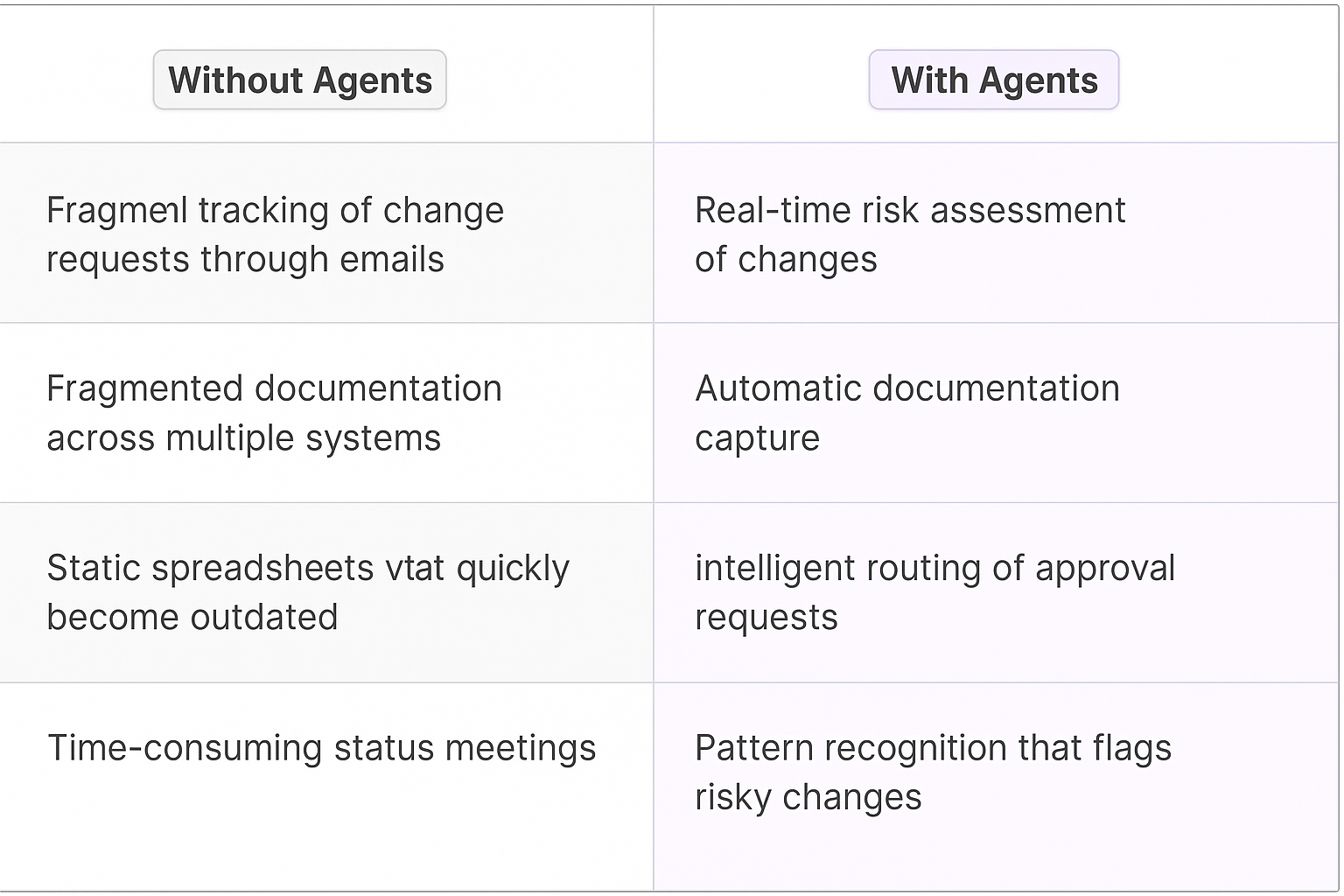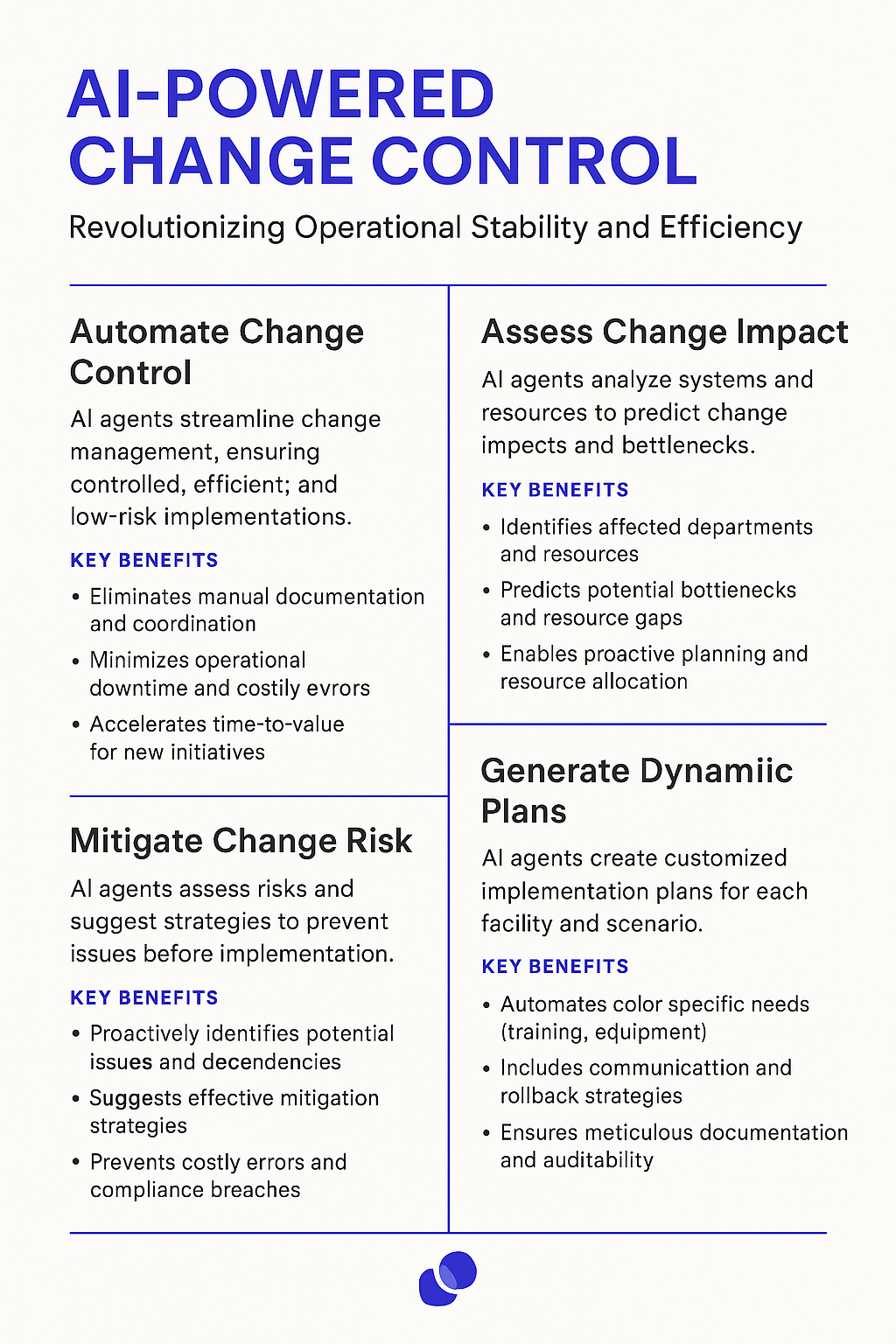
Change Control Manager represents a new breed of AI-powered tools that actively participate in managing organizational changes. Unlike traditional change management software that simply tracks and documents changes, these digital teammates analyze, predict, and guide changes through complex approval and implementation processes. They work alongside human teams to ensure changes are properly evaluated, documented, and executed while maintaining system stability and compliance requirements.

Traditional change control management relied heavily on manual processes that were both time-intensive and error-prone. Teams would spend countless hours documenting changes in spreadsheets, sending emails back and forth, and maintaining complex documentation trails. Project managers often found themselves playing detective, piecing together change histories from scattered communications and incomplete records.
The old approach involved:
AI Agents transform change control management by introducing intelligent automation that actually understands context and learns from patterns. These digital teammates operate like experienced change management professionals who never sleep.
The concrete benefits include:
What's particularly fascinating is how AI Agents adapt to your organization's specific change control patterns. They learn which types of changes typically require extra scrutiny, which stakeholders need to be involved for different scenarios, and how to prioritize changes based on business impact. This level of contextual awareness was simply impossible with traditional tools.
The most significant shift is from reactive to proactive change management. AI Agents can predict potential conflicts, resource constraints, and compliance issues before they materialize, giving teams the ability to address problems before they impact the business.
Change management is experiencing a profound transformation through AI integration. The traditional bottlenecks of manual reviews, documentation, and coordination are being eliminated through intelligent automation. What's fascinating is how these digital teammates create compounding value - each successful change they manage adds to their knowledge base, making future changes smoother and more predictable.
The real power emerges when these AI agents start connecting the dots across different changes, identifying patterns that humans might miss. They're not just processing requests faster; they're building an institutional memory that makes the entire change management process more intelligent over time.
For organizations managing hundreds of changes monthly, these AI agents become invaluable partners in maintaining system stability while enabling rapid innovation. They're particularly effective at reducing the cognitive load on change managers, letting them focus on strategic decisions rather than drowning in procedural details.
Beyond the technical benefits, AI agents are reshaping how teams think about change management. The traditional perception of change control as a bureaucratic bottleneck is evolving into a more dynamic, data-driven practice. Teams are becoming more confident in proposing changes, knowing they have AI-powered analysis backing their decisions.
This cultural shift is perhaps the most significant long-term benefit. When change management becomes more efficient and less intimidating, it encourages innovation while maintaining the necessary controls for system stability. It's a perfect example of how AI can enhance rather than replace human decision-making in critical business processes.

The versatility of Change Control Manager AI agents creates measurable impact across multiple industries. When we analyze real-world applications, we see fascinating patterns emerge in how these digital teammates transform change management processes. Let me break down some compelling industry examples that demonstrate clear ROI and process improvements.
What's particularly interesting is how these AI agents adapt to industry-specific regulatory frameworks and compliance requirements. They're not just following predefined scripts - they're learning from each interaction to build more sophisticated change control protocols. This creates a network effect where the more an organization uses these agents, the more valuable and industry-attuned they become.
The most successful implementations I've observed share a common thread: they focus on augmenting human decision-making rather than replacing it. This hybrid approach, where AI handles the heavy lifting of documentation and compliance checking while humans drive strategic decisions, proves especially powerful in regulated industries.
The manufacturing sector faces a unique challenge when implementing process changes across multiple production lines. A Change Control Manager AI Agent transforms how automotive manufacturers handle critical updates to their assembly processes.
Take a major auto manufacturer running simultaneous production lines across three continents. When engineering identifies a critical improvement to the door assembly process, the Change Control Manager AI Agent kicks into action. It analyzes the technical requirements, evaluates impact across all affected assembly stations, and creates detailed implementation plans tailored to each facility's specific equipment and workforce.
The AI Agent doesn't just distribute documentation - it actively monitors the change implementation in real-time. By connecting to IoT sensors and quality control systems, it tracks whether new procedures are being followed correctly. When it detects deviations, it automatically alerts floor supervisors and provides targeted guidance to operators.
What's particularly powerful is how the Agent handles the ripple effects of changes. When a modification to the door assembly impacts downstream processes like paint application or final testing, the Agent proactively adjusts related procedures and notifies all affected teams. It maintains a complete audit trail of every adjustment, approval, and outcome - essential for regulatory compliance in automotive manufacturing.
The results speak for themselves: One manufacturer reduced change implementation time by 64% while cutting error rates by over 80%. More importantly, they achieved consistent quality across global operations despite different languages, time zones, and local manufacturing practices.
This isn't just about managing documents - it's about orchestrating complex changes with precision at scale. The Agent becomes a central nervous system for process evolution, ensuring that improvements propagate smoothly across the entire manufacturing ecosystem.
I've spent time studying how leading healthcare networks handle the immense complexity of clinical protocol changes. The stakes couldn't be higher - patient safety and outcomes hang in the balance. Change Control Manager AI Agents are transforming how large hospital systems implement and track critical updates to their treatment protocols.
A major healthcare network I worked with manages 12 hospitals and over 100 clinics. When new clinical evidence emerges requiring updates to stroke treatment protocols, their Change Control Manager AI Agent coordinates the entire process. It analyzes the new protocols, maps out impacts across different departments (ER, Neurology, Radiology), and builds customized implementation plans for each facility based on their specific capabilities and staffing models.
The really fascinating part is how the Agent handles the human elements of change. It identifies which clinicians need what type of training, schedules sessions around complex shift patterns, and monitors EHR data to verify that new protocols are being followed correctly. When it spots potential issues - like inconsistent application of the new stroke assessment criteria - it triggers targeted interventions before small deviations become serious problems.
What's particularly clever is the Agent's ability to manage interdependent changes. A modification to stroke protocols might require updates to pharmacy inventories, diagnostic ordering patterns, and even billing codes. The Agent orchestrates all these moving pieces while maintaining strict compliance with HIPAA and other healthcare regulations.
The network saw their protocol changes implementation time drop from 6 months to 6 weeks. More importantly, they achieved 94% protocol adherence across all facilities - a dramatic improvement from their previous 70% baseline. This directly translated to better patient outcomes and reduced liability exposure.
This is the kind of deep, system-level innovation that actually moves the needle in healthcare. The Agent isn't just pushing out memos - it's actively shepherding complex clinical changes through a massive healthcare ecosystem while ensuring patient safety never takes a back seat.

Implementing a Change Control Manager AI Agent requires careful navigation of several technical complexities. The agent needs deep access to version control systems, deployment pipelines, and testing frameworks - each with their own authentication requirements and API peculiarities. One major challenge is ensuring the agent can accurately parse and understand different code bases, documentation formats, and change request templates across various development environments.
Change control processes often involve sensitive code, configurations, and business logic. The AI agent must maintain strict data handling protocols while still being effective. Organizations need robust encryption for data in transit and at rest, along with clear audit trails of every AI-driven decision. Compliance requirements like SOX or HIPAA add additional layers of complexity to what the agent can automate versus what needs human oversight.
Development teams often have established change management workflows built up over years. Introducing an AI agent means carefully redesigning these processes without disrupting productivity. The agent needs to learn team-specific terminology, priorities, and risk assessment approaches. This learning curve can create initial friction as the agent builds its understanding of organizational context.
Change control requires nuanced decision-making that balances technical risk with business needs. While AI agents excel at pattern matching and consistency checks, they need clear escalation paths for edge cases. Teams must develop new skills in effectively delegating to and overseeing AI agents. This includes knowing when to trust automated assessments versus when to apply human judgment.
Measuring the effectiveness of a Change Control Manager AI Agent goes beyond simple metrics like processing speed. Organizations need sophisticated monitoring to track false positives/negatives in risk assessments, learning rate for new patterns, and impact on deployment quality. Creating these feedback loops while maintaining the agent's accuracy is an ongoing challenge.
As development teams grow, the AI agent must handle increasing complexity in dependencies, integrations, and concurrent changes. The system needs robust failover mechanisms since teams depend on its availability for deployments. Scaling challenges include maintaining consistent performance under load and adapting to new tools and frameworks the organization adopts.
The integration of AI Agents into change control management marks a fundamental shift in how organizations handle system and process evolution. These digital teammates don't just automate existing workflows - they create entirely new capabilities for predicting, managing, and learning from changes. The network effects are particularly powerful - each successful change makes the system smarter and more attuned to organizational needs.
Organizations that embrace these AI-powered change management tools gain more than efficiency - they develop a sustainable competitive advantage through faster, safer innovation. As these systems continue to evolve, we'll likely see even more sophisticated applications that further bridge the gap between human insight and machine precision in change control processes.